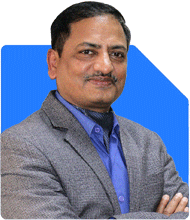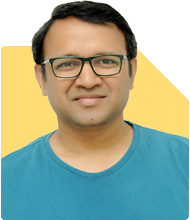Ramalingam Kalirajan |8291 Answers |Ask -Follow
Mutual Funds, Financial Planning Expert - Answered on Jun 26, 2024
He has an MBA in finance from the University of Madras and is a certified financial planner.
He is the director and chief financial planner at Holistic Investment, a Chennai-based firm that offers financial planning and wealth management advice.... more
.jpg)
We are family of 3 my husband 43 years myself 40 years my daughter 10 years .no loans monthly earnings approx 4 lakhs . We plan to retire at 55 years . Monthly expenses approx 1 lakh what should be our retirement fund considering my daughter education also .
Setting Retirement Goals
You aim to retire at 55, which is in 15 years. It’s crucial to assess your financial goals, including your daughter’s education and lifestyle after retirement.
Estimating Post-Retirement Expenses
After retirement, your expenses may change. While some expenses like commuting will reduce, healthcare and leisure might increase. Assume monthly expenses of Rs 1 lakh now. Post-retirement, adjusting for inflation, this could be around Rs 2.4 lakhs per month.
Accounting for Inflation
Inflation significantly impacts long-term financial planning. Assuming an average inflation rate of 6%, your current Rs 1 lakh monthly expense will need to grow to cover higher costs in the future.
Daughter’s Education Fund
Higher education costs are rising. Let’s estimate a fund for your daughter’s college education, considering current and future costs. A reputed Indian college might cost around Rs 25-30 lakhs today, which will likely increase over the next 8 years.
Building a Retirement Corpus
Given your retirement timeline, you need to build a significant corpus. This will support your lifestyle and healthcare needs. Your current earnings give you a solid base to start with.
Investment Strategy
Diversified Portfolio
Investing in a diversified portfolio is key. Consider equity, debt, and hybrid funds. Equities can offer higher returns, while debt provides stability. Hybrid funds balance the two.
Actively Managed Funds
Actively managed funds often outperform index funds in the long run. Professional fund managers adjust the portfolio based on market conditions, potentially offering better returns.
Regular Mutual Funds Through CFPs
Regular mutual funds, managed by a certified financial planner (CFP), can be advantageous. CFPs provide professional advice, helping you navigate market complexities and optimize returns.
Emergency Fund
Maintain an emergency fund. It’s essential for unexpected expenses. Aim for 6-12 months’ worth of expenses in a liquid, easily accessible form.
Insurance Coverage
Ensure adequate health and life insurance. Health insurance is critical, especially as you age. Life insurance protects your family’s financial future. Avoid investment-cum-insurance policies; pure insurance products are better.
Surrendering Unproductive Policies
If you hold LIC, ULIP, or investment-cum-insurance policies, consider surrendering them. Reinvest the proceeds into mutual funds. These policies often have high charges and low returns.
Tax Planning
Efficient tax planning can save money. Utilize tax-saving instruments under Section 80C, 80D, and others. Mutual funds like ELSS can help save tax while providing good returns.
Monitoring and Reviewing
Regularly monitor and review your investments. Financial goals and market conditions change. Adjust your portfolio as needed, ideally with the help of a CFP.
Early Retirement Considerations
Retiring early at 55 means your corpus needs to last longer. Plan for at least 30 years post-retirement. This requires a careful balance of growth and safety in your investments.
Role of Certified Financial Planners
CFPs offer expertise in creating a holistic financial plan. They help in choosing the right investments, optimizing returns, and ensuring your goals are met efficiently.
Benefits of Actively Managed Funds
Actively managed funds adapt to market changes. Skilled managers can capitalize on opportunities and mitigate risks better than passive index funds. They also offer personalized investment strategies.
Addressing Direct Fund Disadvantages
Direct funds require individual management. They lack professional guidance, which can lead to suboptimal decisions. Investing through a CFP ensures professional management and better alignment with your goals.
Contingency Planning
Always have a contingency plan. Unexpected events can derail your financial plans. A solid contingency fund and insurance coverage provide a safety net.
Education Planning
For your daughter’s education, consider child-specific mutual funds. These funds are tailored to meet educational expenses, providing both growth and safety.
Retirement Lifestyle
Visualize your retirement lifestyle. Consider hobbies, travel, and other activities you wish to pursue. Budget for these, ensuring you have enough funds to enjoy your retirement fully.
Final Insights
Planning for retirement is a multifaceted process. It requires a balanced approach, considering various aspects like inflation, education, and lifestyle. Engaging with a certified financial planner can significantly enhance your financial journey, ensuring you meet your retirement goals comfortably.
Best Regards,
K. Ramalingam, MBA, CFP,
Chief Financial Planner,
www.holisticinvestment.in
You may like to see similar questions and answers below
Sanjeev Govila |458 Answers |Ask -Follow
Financial Planner - Answered on Apr 02, 2024
Ramalingam Kalirajan |8291 Answers |Ask -Follow
Mutual Funds, Financial Planning Expert - Answered on May 24, 2024
Ramalingam Kalirajan |8291 Answers |Ask -Follow
Mutual Funds, Financial Planning Expert - Answered on Jul 11, 2024
Ramalingam Kalirajan |8291 Answers |Ask -Follow
Mutual Funds, Financial Planning Expert - Answered on Sep 20, 2024
Dr Nagarajan Jsk |346 Answers |Ask -Follow
NEET, Medical, Pharmacy Careers - Answered on Apr 25, 2025
Nayagam P P |4463 Answers |Ask -Follow
Career Counsellor - Answered on Apr 25, 2025
Nayagam P P |4463 Answers |Ask -Follow
Career Counsellor - Answered on Apr 25, 2025
Nayagam P P |4463 Answers |Ask -Follow
Career Counsellor - Answered on Apr 25, 2025
Patrick Dsouza |1030 Answers |Ask -Follow
CAT, XAT, CMAT, CET Expert - Answered on Apr 25, 2025
Dr Dipankar Dutta |1168 Answers |Ask -Follow
Tech Careers and Skill Development Expert - Answered on Apr 25, 2025
Dr Dipankar Dutta |1168 Answers |Ask -Follow
Tech Careers and Skill Development Expert - Answered on Apr 25, 2025
Dr Dipankar Dutta |1168 Answers |Ask -Follow
Tech Careers and Skill Development Expert - Answered on Apr 25, 2025
Radheshyam Zanwar |1566 Answers |Ask -Follow
MHT-CET, IIT-JEE, NEET-UG Expert - Answered on Apr 25, 2025
Radheshyam Zanwar |1566 Answers |Ask -Follow
MHT-CET, IIT-JEE, NEET-UG Expert - Answered on Apr 25, 2025
























